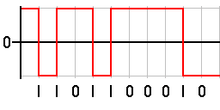Signal edge
In electronics, a signal edge is a transition of a digital signal from low to high or from high to low:
- A rising edge (or positive edge) is the low-to-high transition.[1]
- A falling edge (or negative edge) is the high-to-low transition.[1]

Signal edges shown in rectangular pulse amplitude modulation with polar non-return-to-zero, inverted coding waveform
In the case of a pulse, which consists of two edges:
- The leading edge (or front edge) is the first edge of the pulse.
- The trailing edge (or back edge) is the second edge of the pulse.
See also
- Flip-flop (electronics), an edge-triggered circuit
- Rise time, for a signal transition
References
- Berger, Arnold S. (20 May 2005), Hardware and Computer Organization, p. 32, ISBN 978-0-7506-7886-5
This article is issued from Wikipedia. The text is licensed under Creative Commons - Attribution - Sharealike. Additional terms may apply for the media files.